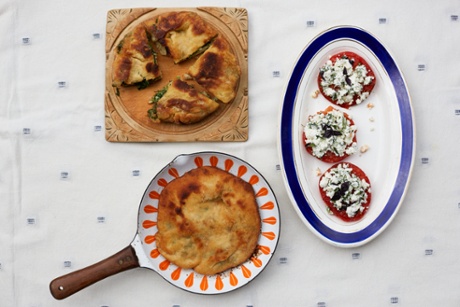Both of my great grandmothers were half-Moldovan. I know a lot more about my maternal great-grandmother, Yaryna, whose family came from Bessarabia, an area south-west of Ukraine where the two countries meet. I wish I’d had the sense to ask her daughter – my grandmother Lusia – more about her roots while she was alive. She never actually spoke Moldovan, but often told us off in Yiddish. “Meshugene kop!” she would shout (which we understood to mean “stupid head”).
Bessarabia was a cultural melting pot in itself – Moldovans, Romanians, Jews, Ukrainians, Gagauz people and Germans all lived side by side, and evidently dishes were borrowed, fused, adapted and passed on through generations with extraordinarily lavish results.
Of course, that wasn’t always the case. Amid devastation and hunger in postwar Ukraine, Lusia moved from the south of the country where she grew up back to her mother’s Bessarabian village, Parizh (Paris).
Bread was awful in Soviet shops, especially after the drought of 1963, under Khrushchev, who prioritised the growing of corn to feed cattle in Ukraine to the detriment of all other crops, including the wheat used to make bread. Shops were far from the village and always mobbed with people. As a little boy, my uncle Slava would dive into the sea of legs, expertly navigating his way to the front of the crowd.
My grandmother was so appalled at what was happening in the shops, she started doing what her Moldovan mother did. She used the whey left over from making curd cheese (syr) to whip up a mountain of plachyndy (spelled placinte in Moldovan) – flatbreads stuffed with either dill and salty curd cheese or sweetened grated pumpkin. She would leave them on the table for her six children to snack on throughout the day, while she tended to her animals and her vegetables.
My gentle and infinitely kind grandfather Viktor found work as a lorry driver and Lusia would make a poor man’s version of the plachyndy for him – we called him Dedushka – as packed lunch. One day, she noticed Viktor was about to faint after work. It turned out he had given away all the flatbreads my grandmother prepared for him to the starving people on the streets – and did so regularly.
Even when things got better, my grandmother did not get out of that habit of making plachyndy, and vertuta (which also goes by the name invertita) – a giant, crispy cheese twist. Watching my own mother expertly spin and stretch the pastry into a silken, see-through sheet still takes my breath away.
To accompany the plachyndy here, I’ve suggested fried tomatoes with garlicky feta. The south of Ukraine and Moldova have the most wonderful tomatoes. The sun’s strength allows us to grow these gigantic pink beauties – juicy, meaty, sweet and aromatic – which I think are unrivalled by any other tomato in the world. Normally we eat them as they are, without even salt, but sometimes I love frying them and sprinkling them with salted curd cheese mixed with crushed garlic, the aniseed-y purple basil that grows in my mum’s garden like a weed and, of course, dill.
In Moldova, brinza, or local sheep’s cheese, would have been used, but in its absence Lusia would have made do with heavily salted curd cheese. This way, it also kept all throughout the winter when their cow was pregnant and couldn’t be milked. Ukrainians have always been amazing at adapting other cuisines to the ingredients at hand. I’ve learned to do that in the UK too. I live in north London on Green Lanes, where Turkish and Greek communities have settled, and find that using feta works a treat in this recipe. Moldovan food has historically been heavily influenced by Greeks and Turks, so we have now come full circle.
Plachyndy with herbs and egg
These are also delicious with a little bit of feta mixed in, or with sugared, grated pumpkin and vanilla seeds to be eaten as dessert.

Makes 4
250ml kefir or buttermilk
½ tbsp distilled vinegar
½ tbsp sugar
1 tsp salt
300g plain flour, plus extra for dusting
½ tsp bicarbonate of soda
For the filling
50g sorrel, finely chopped
4 spring onions, finely chopped
1 small bunch of dill, chopped (stalks and all)
1 small bunch of parsley, chopped
2 eggs, lightly beaten
4 tbsp sunflower oil, plus 100ml for frying
1 Add the kefir, vinegar, sugar and salt to a large bowl and mix well with a fork. Sift the flour with the soda into the kefir mixture
and mix to obtain a soft and pillowy dough.
2 Heavily flour your work surface, tip out the dough and start kneading, incorporating more flour as needed. The dough should stop sticking to your hands, but it should also remain soft.
3 Mix the sorrel, spring onions, dill and parsley together, then stir through the eggs. You can gently heat this mixture in a pan to help the egg coagulate a little bit, so it’s not too runny when you put it on the pastry.
4 Divide the dough into four equal pieces and flour the surface really well. Roll out each piece of dough, one by one, into a 20cm disc.
5 Moisten the surface of the pastry with about 1 tbsp sunflower oil and spread equal quantities of the filling over the whole surface of each circle.
6 Now for each flatbread, fold opposite sides of the pastry to make a parcel. Then fold the parcels corners into the centre, creating a moneybag shape.
7 Make sure all of the edges are firmly pinched inside, flour the top lightly and gently flatten the moneybag with your rolling pin or with your hand.
8 Heat the remaining 100ml of sunflower oil in a pan until hot and gently lower in each flatbread, one after the other. The first one will take around 4 minutes per side but, as the oil heats up, the next ones will take around 3 minutes per side. You can also brush them with oil and cook them under your grill. The result will be a bit different, but still delicious.
Moldovan fried tomatoes with cheese, garlic and herbs
This is a really simple recipe. Make sure you use flavoursome tomatoes – it’s their sweetness that works so well with the salty cheese.

Serves 4
2 beef tomatoes, sliced in two on the equator
1 tbsp sunflower oil
150g feta, crumbled
1 large garlic clove, finely grated
½ small bunch of dill, finely chopped
A few purple (or regular) basil leaves, picked or gently sliced
1 Heat the oil in a pan and gently fry the tomatoes until they are just starting to colour but are still firm.
2 Mix the crumbled feta with the garlic and herbs and sprinkle over the tomatoes when ready to serve.
• Olia Hercules is the author of Mamushka, (Octopus, 2015) Twitter: @oliasgastronomy









